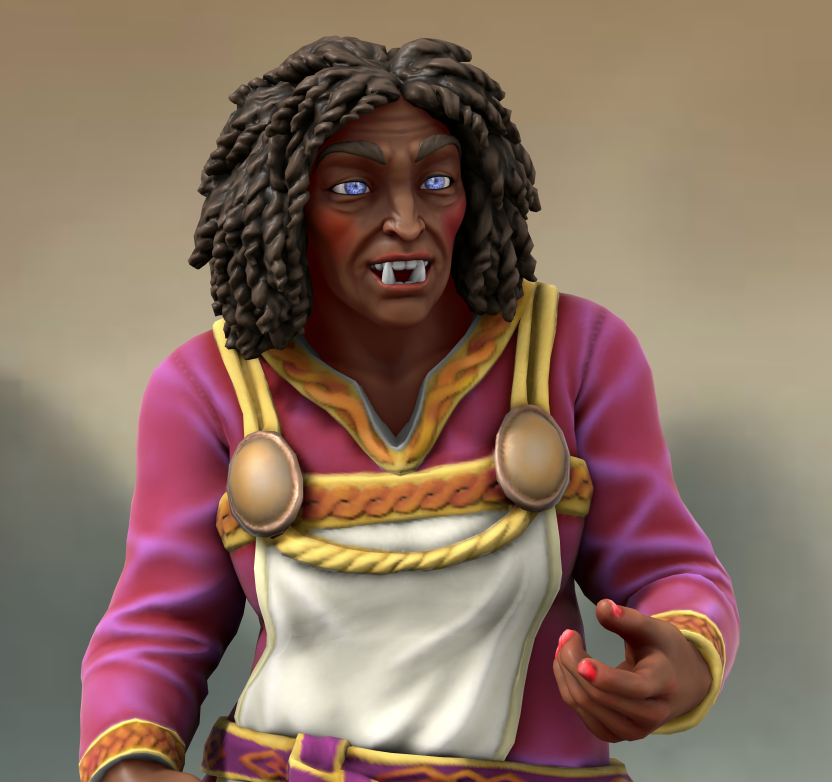Lytan's Mill
Geography and Description
Lytan’s Mill is a large town, not quite a city, although some like to think of it as a small city. But historians and city planners know otherwise. It controls the confluence of two rivers, the Grushagûl River, and the Zaar River. Upstream, the Grushagûl River continues west towards the mountains. The other waterway, the Zaar River, has its source in the east, somewhere around Mount Ecrins. The main family in Lytan's Mill, is, of course, the Lytans. They still own or control the most land in the area. They had founded the city hundreds of years ago, starting off as lumber barons, supplying wood products and building supplies to towns and villages up and down the river. Lumber is no longer the primary export, although lumber and paper still make up a good portion. The exports have diversified, and include beer, treesilk, cinnamon, and cocoa. The beer uses a special variety of hops that only grows in the local area, which gives their lagers and ales a unique taste.The area used to be part of a loose federation of Orcish tribes, before getting taken over by the Empire. As far as old temples, there aren’t any surviving. The jungle has had something like eight centuries to swallow them up. If one looked hard enough they would find some ruins, although one might have to excavate them. The whole area used to be the border between old Araterre and the lands of the Orc tribes. Lytan’s Mill is built on the ruins of an old Orc village, although nothing remains of it. It’s been completely built over.
As one nears town, one can start to see farms, scattered here and there in the jungle near the river. Unlike the area around Port Karn, which is a patchwork mosaic of farmland, cleared from the jungle over centuries, the farms around Lytan’s Mill are more spread out, and each is in its own pocket of cleared land. Each one is surrounded by jungle. Most likely, the land owned extends past the farmland, but hasn’t been fully cleared of jungle yet.
The farmlands have various crops, ranging from grains, vegetables, and livestock. Notably, there are also several farms with strings of hops growing on them.
Lytan’s Mill is partially walled since there are no walls over the rivers. The walls were about ten meters high, made of stone, and old. There are capstans in the towers that flank the river, connected to chains that most of the time lie along the river's bottom. When necessary, the chain can be raised by the capstans to block most boats from progressing up or down the river. Most of the town is behind the walls, with most buildings being 3-4 stories in height, and very close together. It feels crowded. Outside the walls on the east side is an unwalled section of town, although it does have a 20’ palisade wall erected to keep wild animals out.
It is a town with a population of around 8000 residents, overwhelmingly Human, but with populations of Orcs, Hobbits, Goblins, and Dwarves, with a very small Elven population.
The town is broken up into the west side, made up of the section of city along the west bank of the Grushagûl, the east side, made up of the section of town east of the rivers Grushagûl and Zaar, and the south side, the section between the two rivers.
While there are docks pretty much all along both rivers, the main commercial wharves are between the west and south parts of town. This is where most of the warehouses ae, some of which are used for locally produced goods, but most are for the short term storage of materials that are in transit through the town, but need to wait for a transport ship to pick them up.
There are two draw bridges across the Grushagûl river as it passes through town. The Bridge of Hope, which is a graceful arc of stone, and Lytan’s Bridge, a much older, squarer bridge. There are two bridges crossing the Zaar River, a wooden trestle bridge simply called the Wooden Bridge, and a stone bridge imaginatively called the Draw Bridge. Only one bridge connects the west side to the south side of town, a large, high bridge called the Bridge of Stone. The bridge is wide enough to have small shops lining both sides, built right up to the edge of the drawbridge sections. When ships approach the drawbridge, bells are rung to alert anyone on the bridges before the drawbridge sections begin to rise.
There are five inns in town. Two in the east side, two in the west, and one in the south part of town. The South Side Inn is in the south part of town, and it caters to sailors. It’s pretty bare bones, but it’s shelter, and it’s the cheapest place to stay. The ones on the east side are the Marbled Lady, which is pretty high end, and the Laughing Fox, which is mid priced, and caters to caravaners. The two in the west side are both mid range, Momma’s, and the Rain Song.
The streets are narrow, and have few alleyways between the buildings. For the most part, the buildings are built right up to each other, forming blocks of segmented housing and shops. The more commercial and industrial buildings have a bit more space around them so that wagons can get in to move supplies and goods.
There is an old Elven hermit living just out of town, in a treehouse. She is a wise woman, but cranky and doesn’t like visitors. It is thought that her house is surrounded by acres of Elven boobytraps and dangerous plants. Rumor says she eats children, although that’s likely just old wives’ tales to keep children in line.
Economics
Lumber is no longer the primary export, although lumber and paper still make up a good portion. The exports have diversified, and include beer, treesilk, cinnamon, and cocoa.They export fine beers, and have three breweries in the city, each with some unique brews. There is a local hops that isn’t grown anywhere else that give the beers a fruity-savory flavor that is unlike anything else. Its complex notes work very well with the other beer ingredients. Many of the beers are shipped to Port Karn, along with other places in the Empire.
Notable Locations
Laughing Fox
Inn located in the East Side. It is a large building, with three stories. The entire first floor is the stables, and there is a large open space surrounded by a three meter high stone wall where wagons are parked. There are three privies lined up side by side in that open space, and there is a guard keeping watch over the laden wagons. The inn has a bath house attached at the back. In the front, there are two doors, one rather large, and one of a more normal size. The inn is entered through the smaller door; the stables through the larger one.South Side Inn
Inn located in the South Side. It’s the largest of the 5 inns in town, and the cheapest. No staterooms, no suites, just eight rooms, each with two triple beds in them. Overflow space is provided in the common room, where people can spread out their sleeping furs. The inn is run by an old sailor named Corbin Aylesley, who “retired” from plying the river and opened up an inn. On either side of the inn are two taverns. One is the Randy Stoat, and the other is the Puking Unicorn, complete with a sign that shows a wobbly-legged unicorn with its face in a bucket. Behind the innkeeper’s counter are three signs, advertising for the three local breweries. The first shows a hammer slamming into an anvil, where the head of the hammer is a beer stein (Hammer and Anvil Hilltop Hideaway, simply the name of the brewery in a sweeping hand with flourishes; and The Laughing Dragon, showing a fat and happy round-bodied dragon, laughing with mirth.Randy Stoat
Tavern next to the South Side Inn.The Puking Unicorn
The other tavern next to the South Side Inn. Its signage shows a wobbly-legged unicorn with its face in a bucket.Ralga Stouttusk
Loremaster and local historian. Her house was on the west side, in the northern part of the city. It stands four stories tall, like most of the buildings in town, made of stone and narrow. The first floor is both her parlor, and a local museum. She has a low, husky voice. Ralga StouttuskRain Song Inn
Located on the West Side. It’s three blocks from Momma’s, and between the two inns are two taverns (Salty Dog Tavern; The White Snail).Salty Dog Tavern
Cheaper than The White Snail. Food is poor, but serviceable.The White Snail
A little more expensive, and it has serviceable drinks, decent food, but with good portions.Hammer and Anvil Brewery
It is a tall stone building that looks like it had once been a warehouse. There are two doors, a loading door and a main entrance door. Inside, it looks something like a sparsely furnished tavern. Along one wall is a bar, with stools placed in front of it. Scattered about the large room are some tables with chairs. The bar stools are adjustable, by spinning the seat. A threaded screw then allows the seat to raise or lower, as the patron preferred. Across the wall behind the bar are several signs, detailing what beers the brewery makes, and which ones were on tap at the moment.Jaddood’s Street Kitchen
It's owned by a Goblin woman by the name of Tediito Jaddood, although she employs cooks of all species. She is old, and semi-retired, having opened the business 20 years ago. They make a really good Gabriki Saari (grilled strips of beef and pork, in a spicy-sweet orange glaze, garnished with honey glazed and roasted crickets, and rolled up in leafy greens). Their Hariki Tanook is good too (a kind of dumpling made with ground meats, hot peppers, onion, garlic, a collection of spices that included cinnamon and nutmeg, wrapped in dough made with bacon fat, boiled until mostly cooked, then finished in a frying pan to sear the edges. It is usually served with a collection of hot sauces.)Agron's Alchemical Elixirs
Once a busy, succcessful alchemist's shop, it suffered an "unexpected sudden disassembly event". Evening of Spiritsday, Leafturn 14, 879 AFE: An explosion rocked the South Side of Lytan’s Mill in the middle of the night. An alchemist’s shop down the street from the South Side Inn blew up, setting fire to neighboring buildings and causing disorientation, confusion, and mental lapses to those nearby, hampering firefighting efforts. Eventually, the fire was put out, with the assistance of a mage who was able to extinguish large areas of flame, greatly accelerating the efforts to get the fire under control. The alchemist shop was completely destroyed, and the neighboring buildings badly damaged, but repairable. The shop had been on the ground floor, with their living quarters above it. The alchemist, Agron Gerlof, had lived there with his family, consisting of his wife and two children. The cause of the blast was apparently due to a break in, and some thugs knocked something over into a cauldron filled with a brewing alchemical mixture. It started bubbling, and shooting sparks. Agron barely got his family outside when the whole building blew up. The whereabouts of the two thugs are unknown; but Agron doesn’t think they made it out of the building before it turned into a flaming ball of debris. All told, six people died, four are unaccounted for, and over a dozen are wounded. Some of those wounded likely didn’t survive. However, there was a general sense of victory in the town; it was a big fire, and dangerous, but they had fought it and won, with a minimum of casualties. Agron Gerlof, alchemistLytan's Gateway
Downriver by about four miles are a pair of 4m tall statues of Orcs, in ancient battle garb, one on each bank of the river, facing each other. Both were done in an angular, abstracted style carved in grey granite, and each wore a feathered collar done in mosaic. Many of the colored stones and glass of the mosaic were missing, lost over the centuries. The statues were sculpted with hide loincloths, and feathered wrist decorations, also done in multicolored mosaics. They were posed standing with their arms down at their sides, grim looks on their angular, tusked features, and looking across the river at each other. They each stood about four meters tall. They are referred to as “Lytan’s Gateway”, although they predate the town. The statues? No one remembers their names, or their tribes. But those two statues depict the champions of two warring tribes. The enmity had been great, and long lasting. Generations. The two tribes hated each other with the fierceness of stubborn Orcs. But one called out the other, requesting an honor duel to decide who won the war between them. And those two fought, with the tribes folk as audience. Axes clattered off of armor, and they beat on each other for a full day until their axes broke under the strain. They fought on with fists and tusks, and by the end of the second day, their armor had been torn to pieces and scattered about the clearing where they fought. Yet still they weren’t done, trading fist and kick and grunting in pain and defiance. By the end of the third day they could no longer move, and their screams of rage and pride turned into mere mutterings in their exhaustion. Now, the spectators, the members of both tribes, watched this glorious fight progress. Some even set up cook fires, and made food. By the end of the three days, the spectators had mingled, shared food and drink, and discovered that the other tribe wasn’t so bad. The shamans called the fight a draw, and made peace. They remained allies for generations. The two champions were honored with those two statues, placed on either side of the river, forever staring at one another. Some like to think that the two champions became best friends, tenacious and persistent to the end. But who really knows?Legal Considerations
There are two thieves guilds in the city, one controlling the west side, the other controlling the east side. The south side is shared, although really it is up for grabs. There used to be more guilds, but there were some mergers and takeovers, and some other ways of removing the competition, until there were only two left. The two guilds are the Red Bloods, and the Powers. The Red Bloods controls the west side; the Powers controls the east side. They fight for territory in the South Side. Both are deep into the local politics. The Red Bloods and the Powers don’t often mess with the crews of the merchant fleet. Sailors don’t have a lot of money, and the real prizes are the cargos on the boats, or the caravans. But they mostly just charge a tariff on all merchant traffic into the city. They have become almost legitimate. Their fingers are in everyone’s pockets.There is a fairly large Rural Watch contingent in Lytan’s Mill. The way the farms are scattered about make them more necessary. There isn’t much of a City Guard presence, however. It's barely a token force, and a place for the rich to park younger sons and daughters to (hopefully) keep them out of trouble.
Government
Lytan's Mill sits in the corner of Okkiisi Barony. Baron Okkiisi is a vassal of Count Emeraldskin, who in turn is a vassal of Duke Antonian. The barony sits at the edge of Duke Antonian's duchy, and with the exception of Lytan's Mill, lacks any large civic centers. Most of the area controlled by Baron Okkiisi is jungle wilderness, and only about half of the settlements along the Grushagûl River fall under his control, as the border of the barony follows the river along the entire length of the barony. The other bank resides in Gashmokk Barony.The city council runs the day to day operations of the city. The council is made up of minor nobility and wealthy merchants. The real power, however, is the local Baron, who, while not interfering too much or very often, still retains veto power over anything he chooses.
Military
Lytan's Mill has a small force of mostly irrelevant city guardsmen. It's in the older part of the Empire, far from any foreign borders. The most it's had to deal with are little wars between rival nobility.Notable Factions
Merchants guildsThieves' Guilds (The Powers, and The Red Bloods)
Brewer's Guild
Supporting Settlements
Only a few nameless hamlets and scattered clusters of houses and farms.
Type
Town







Comments